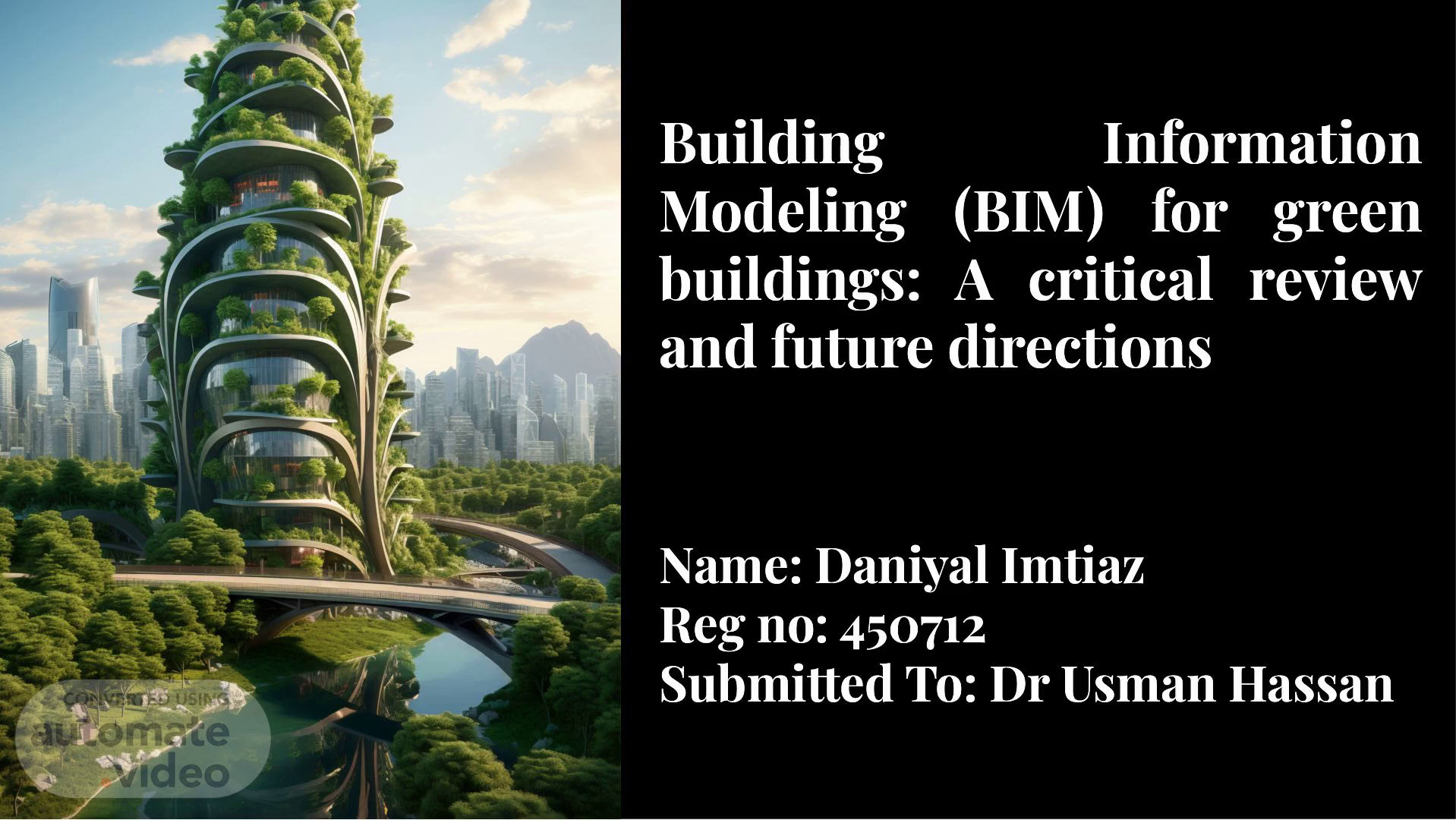Scene 1 (0s)
[Audio] Building Information Modeling (BIM) for green buildings: A critical review and future directions Building Information Modeling (BIM) for green buildings: A critical review and future directions
Scene 2 (17s)
[Audio] Introduction: Introduction: The building and construction industry is increasingly embracing green building strategies to address sustainability concerns, such as reducing CO2 emissions and dependence on fossil fuels. Building Information Modeling (BIM) is recognized as a revolutionary technology offering significant opportunities in the architecture, engineering, and construction (AEC) industry. The building and construction industry is increasingly embracing green building strategies to address sustainability concerns, such as reducing CO2 emissions and dependence on fossil fuels. Building Information Modeling (BIM) is recognized as a revolutionary technology offering significant opportunities in the architecture, engineering, and construction (AEC) industry..
Scene 3 (1m 13s)
[Audio] Research Gap and Objectives: Research Gap and Objectives: Despite widespread recognition of BIM's usefulness, there remains a lack of consensus on its applications for green building development. This study aims to provide a critical review of existing literature on BIM for green buildings and outline future research directions. Despite widespread recognition of BIM's usefulness, there remains a lack of consensus on its applications for green building development. This study aims to provide a critical review of existing literature on BIM for green buildings and outline future research directions..
Scene 4 (1m 50s)
[Audio] Literature Review: Literature Review: Overview of Previous Studies: Examination of BIM's role in sustainable building design, energy efficiency optimization, and environmental impact assessment. Analysis: Evaluation of BIM's effectiveness in supporting green building initiatives and addressing sustainability goals. Key Findings: Identification of challenges, barriers, and best practices in integrating BIM into green building projects. Overview of Previous Studies: Examination of BIM's role in sustainable building design, energy efficiency optimization, and environmental impact assessment. Analysis: Evaluation of BIM's effectiveness in supporting green building initiatives and addressing sustainability goals. Key Findings: Identification of challenges, barriers, and best practices in integrating BIM into green building projects..
Scene 5 (2m 50s)
[Audio] Challenges and Limitations: Challenges and Limitations: Technical Challenges: Compatibility issues, data interoperability, and complexity of BIM software. Cultural and Organizational Barriers: Resistance to change, lack of BIM expertise, and fragmented project workflows. Limitations: Overemphasis on technology, insufficient stakeholder collaboration, and inadequate training and education. Technical Challenges: Compatibility issues, data interoperability, and complexity of BIM software. Cultural and Organizational Barriers: Resistance to change, lack of BIM expertise, and fragmented project workflows. Limitations: Overemphasis on technology, insufficient stakeholder collaboration, and inadequate training and education..
Scene 6 (3m 57s)
[Audio] Future Directions: Future Directions: Opportunities: Leveraging BIM for advanced energy modeling, life cycle assessment, and green building certification processes. Research Areas: Investigating BIMintegrated sustainability metrics, developing standardized BIM protocols for green building projects, and promoting interdisciplinary collaboration. Strategies: Enhancing industry-wide BIM adoption, investing in training and professional development, and fostering a culture of innovation and sustainability. Opportunities: Leveraging BIM for advanced energy modeling, life cycle assessment, and green building certification processes. Research Areas: Investigating BIMintegrated sustainability metrics, developing standardized BIM protocols for green building projects, and promoting interdisciplinary collaboration. Strategies: Enhancing industry-wide BIM adoption, investing in training and professional development, and fostering a culture of innovation and sustainability..
Scene 7 (5m 5s)
[Audio] Conclusion: Conclusion: Summary: BIM offers significant potential for advancing green building practices and addressing sustainability challenges in the construction industry.Importance: Addressing challenges and limitations is crucial for maximizing the benefits of BIM in green building projects. Call to Action: Collaboration between researchers, practitioners, and policymakers is essential for driving innovation and promoting sustainable development in the built environment. Summary: BIM offers significant potential for advancing green building practices and addressing sustainability challenges in the construction industry.Importance: Addressing challenges and limitations is crucial for maximizing the benefits of BIM in green building projects. Call to Action: Collaboration between researchers, practitioners, and policymakers is essential for driving innovation and promoting sustainable development in the built environment..
Scene 8 (6m 11s)
[Audio] Thanks! Thanks!. Thanks! Thanks!.
